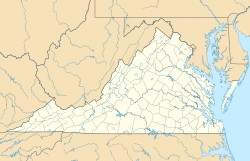
Monument Avenue is a tree-lined grassy mall dividing the eastbound and westbound traffic in Richmond, Virginia, originally named for its emblematic complex of structures honoring those who fought for the Confederacy during the American Civil War. Between 1900 and 1925, Monument Avenue greatly expanded with architecturally significant houses, churches, and apartment buildings. Four of the bronze statues representing J. E. B. Stuart, Stonewall Jackson, Jefferson Davis and Matthew Fontaine Maury were removed from their memorial pedestals amidst civil unrest in July 2020. The Robert E. Lee monument was handled differently as it was owned by the Commonwealth, in contrast with the other monuments which were owned by the city. Dedicated in 1890, it was removed on September 8, 2021. All these monuments, including their pedestals, have now been removed completely from the Avenue. The last remaining statue on Monument Avenue is the Arthur Ashe Monument, memorializing the African-American tennis champion, dedicated in 1996.

The Second White House of the Confederacy is a historic house located in the Court End neighborhood of Richmond, Virginia. Built in 1818, it was the main executive residence of the sole President of the Confederate States of America, Jefferson Davis, from August 1861 until April 1865. It currently sits on the campus of Virginia Commonwealth University.
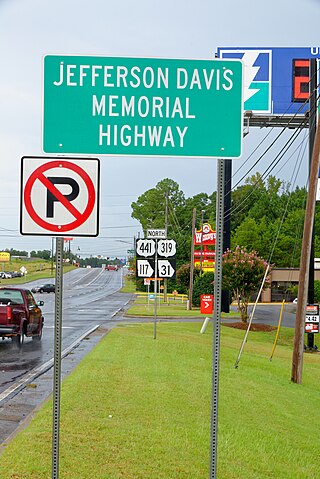
The Jefferson Davis Highway, also known as the Jefferson Davis Memorial Highway, was a transcontinental highway in the United States in the 1910s and 1920s that began in Arlington County, Virginia, and extended south and west to San Diego, California; it was named for Jefferson Davis, President of the Confederate States, United States senator, and Secretary of War. Because of unintended conflict between the National Auto Trail movement and the federal government, it is unclear whether it ever really existed in the complete form that its United Daughters of the Confederacy (UDC) founders originally intended.

Benjamin Banneker: SW 9 Intermediate Boundary Stone, also known as an Intermediate Stone of the District of Columbia, is a surveyors' boundary marker stone. The stone is located on the original boundary of the District of Columbia The stone is now on the boundary of Arlington County, Virginia and the City of Falls Church. It is within the two jurisdiction's Benjamin Banneker Park at 6620 18th Street North, Arlington.

This is a list of the National Register of Historic Places listings in Henrico County, Virginia.
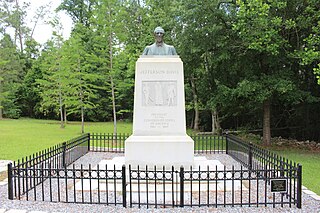
Jefferson Davis Memorial Historic Site is a 12.668-acre (5.127 ha) state historic site located in Irwin County, Georgia that marks the spot where Confederate States President Jefferson Davis was captured by United States Cavalry on Wednesday, May 10, 1865. The historic site features a granite monument with a bronze bust of Davis that is located at the place of capture. The memorial museum, built in 1939 by the Works Progress Administration, features Civil War era weapons, uniforms, artifacts and an exhibit about the president's 1865 flight from Richmond, Virginia to Irwin County, Georgia.
Confederate monuments and memorials in the United States include public displays and symbols of the Confederate States of America (CSA), Confederate leaders, or Confederate soldiers of the American Civil War. Many monuments and memorials have been or will be removed under great controversy. Part of the commemoration of the American Civil War, these symbols include monuments and statues, flags, holidays and other observances, and the names of schools, roads, parks, bridges, buildings, counties, cities, lakes, dams, military bases, and other public structures. In a December 2018 special report, Smithsonian Magazine stated, "over the past ten years, taxpayers have directed at least $40 million to Confederate monuments—statues, homes, parks, museums, libraries, and cemeteries—and to Confederate heritage organizations."

Appomattox is a bronze statue commemorating soldiers from Alexandria, Virginia, who had died while fighting for the Confederacy during the American Civil War. The memorial was located in the center of the intersection of South Washington Street and Prince Street in the Old Town neighborhood of Alexandria.
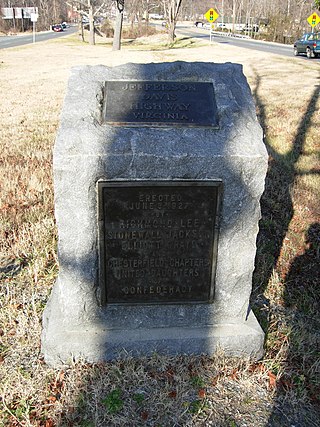
The Brook Road Marker, Jefferson Davis Highway is a commemorative marker on the Jefferson Davis Highway, in Henrico County, Virginia, outside of Richmond, Virginia. The Jefferson Davis Highway was conceived and marked by the United Daughters of the Confederacy, as a counter to the Lincoln Highway in the north, during 1913–1925. In that era, named highways were being marked as automobile travel increased, and the advent of numbered highways eventually loomed. The marker was placed in North Richmond Brook Road, south of Hilliard Road, in 1927. It is one of the earliest, out of 16, that were placed to mark the highway in Virginia by the United Daughters of the Confederacy. It is a 42-inch-high (1.1 m) gray granite stone, with a slanted top, and a bronze plaque.

The Clarendon School is a historic school building located in the Virginia Square neighborhood of Arlington County, Virginia. The structure was erected in 1910 based on a design by noted Virginia architect Charles M. Robinson.

The Bridge at Falling Creek is a historic stone arch bridge located near Richmond, in Chesterfield County, Virginia. It was built about 1823 of rough-cut, uncoursed granite. It is carried by two semicircular barrel arches with voussoirs of rough-finished granite. Its width including parapets is 24 feet (7.3 m), and its length is 148 feet (45 m). It carried the southbound lanes of U.S. Route 301 until 1977, when it was put out of service. It is accessible from a wayside that includes the Falling Creek UDC Jefferson Davis Highway Marker. The bridge was partially damaged in 2004 but still remains significant. It was listed on the National Register of Historic Places in 1995.
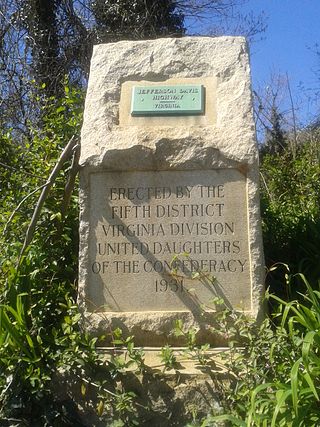
Proctor Creek, Jefferson Davis Highway Marker is a historic stone highway marker located near Richmond, in Chesterfield County, Virginia. It was erected in 1931, and is one of sixteen erected by the United Daughters of the Confederacy in Virginia along the Jefferson Davis Highway between 1927 and 1946. The marker is a gray granite boulder with rough-cut edges. The stone is engraved with the text "ERECTED BY THE FIFTH DISTRICT VIRGINIA DIVISION UNITED DAUGHTERS OF THE CONFEDERACY 1931."

Falling Creek UDC Jefferson Davis Highway Marker is a historic stone highway marker located near Richmond, in Chesterfield County, Virginia. It was erected in 1933, and is one of sixteen erected by the United Daughters of the Confederacy in Virginia along the Jefferson Davis Highway between 1927 and 1946. The marker is a gray granite boulder with rough-cut edges. The stone is engraved with the text “ERECTED BY THE FIRST DISTRICT VIRGINIA DIVISION UNITED DAUGHTERS OF THE CONFEDERACY 1933.” It is located in a wayside established in 1934, that provides access to the Bridge at Falling Creek. It was the first highway wayside park in Virginia.
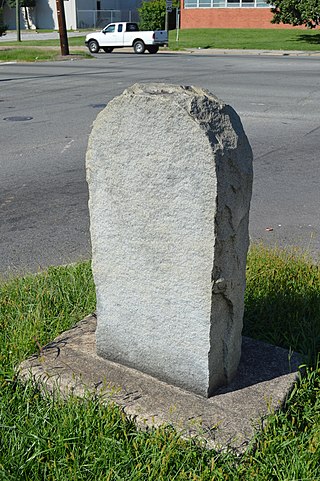
Elliott Grays Marker-Jefferson Davis Highway is a historic route marker located on U.S. Route 1, or Jefferson Davis Highway, in Richmond, Virginia. It was erected in 1929, by the United Daughters of the Confederacy. It is one of 16 erected in Virginia along the Jefferson Davis Highway between 1927 and 1947. The marker is an inscribed granite slab with smooth flat faces and rough-cut edges. It measures 47 inches tall, 25 inches wide and 12 inches thick. The stone is engraved with the text "Jefferson Davis Highway This tree marks the site of Battery 17 of the inner defenses of Richmond, 1862-65, and is planted in soil taken from battlefields A memorial to Confederate Soldiers by the Elliott Grays Chapter U.D.C. 1929."

The Jefferson Davis Highway Marker is a commemorative marker on the Jefferson Davis Highway, in Hanover County, Virginia, near Ashland. It is a 42-inch-high (1.1 m) gray granite stone, with a slanted top, with two bronze plaques. The Jefferson Davis Highway was conceived and marked by the United Daughters of the Confederacy, as a counter to the Lincoln Highway in the north, during 1913–1925. In that era, named highways were being marked as automobile travel increased, and the advent of numbered highways eventually loomed. The marker was placed at the junction of what is now US Route 1 and Cedar Lane, between Richmond and Ashland, in 1927. It has been moved twice: in the 1970s it was moved to accommodate the widening of Route 1, and it was moved across Route 1 in the 1980s.

Jefferson Davis Park is a private park located outside Ridgefield, Washington, in the southwestern portion of the state. The granite markers of the unofficial Jefferson Davis Memorial Highway are at the center of the park surrounded by Confederate flags. Operated by the Pacific Northwest chapter of the Sons of Confederate Veterans, the park commemorates Jefferson Davis, the pro-slavery President of the Confederate States of America.

